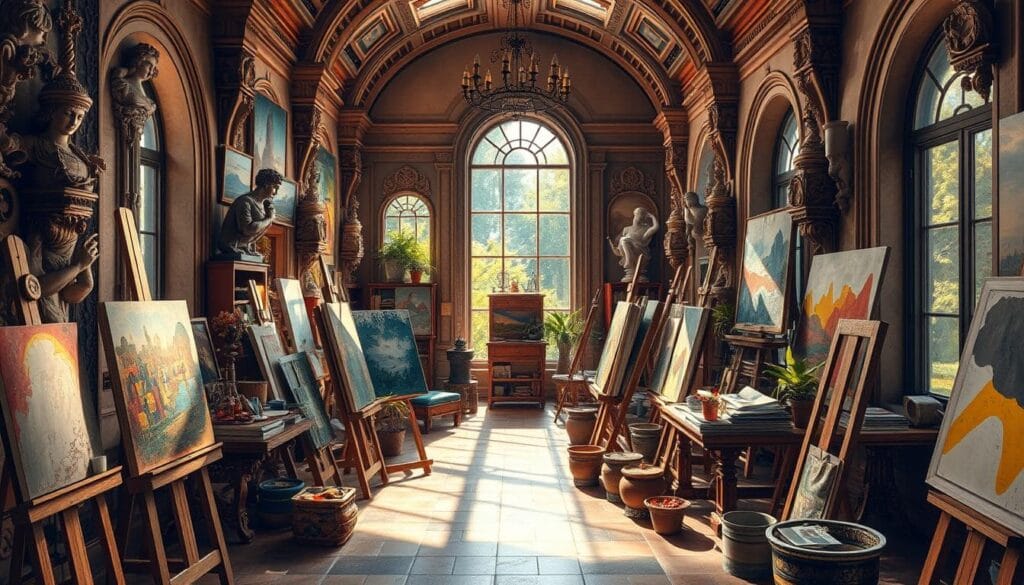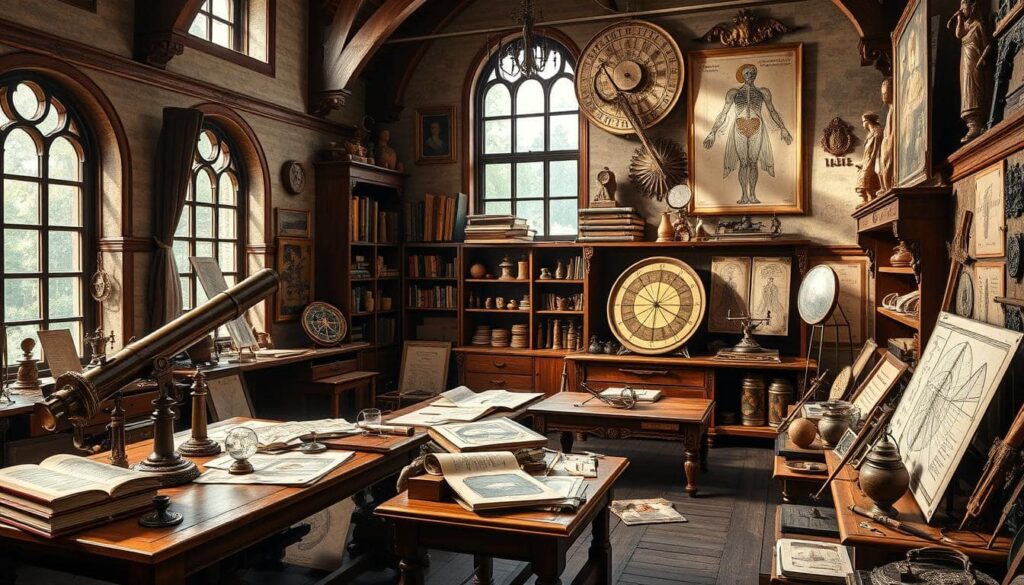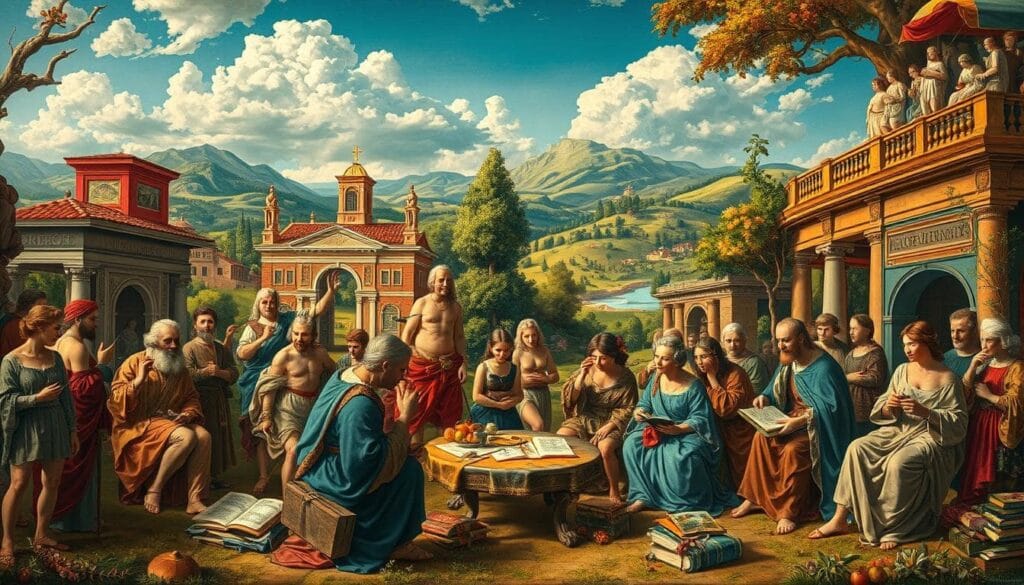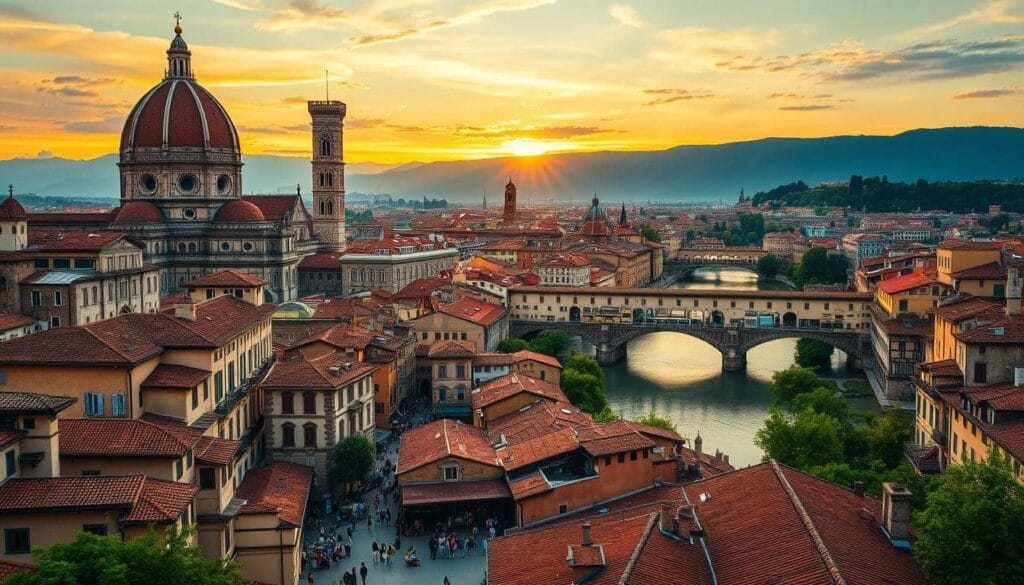The history of the Renaissance is truly captivating. To grasp its essence, we must explore its meaning and definition. This era, spanning from the 14th to the 17th century, saw a surge in interest in ancient Greek and Roman cultures. It was also a time of humanism and individualism, key to understanding the Renaissance.
This period was marked by great leaps in art, science, literature, and philosophy. These advancements deeply influenced Western society. Studying the Renaissance offers a glimpse into the cultural and intellectual achievements of that time.

- The Renaissance was a cultural and intellectual movement that took place in Europe between the 14th and 17th centuries.
- The renaissance meaning is rooted in the renewed interest in classical Greek and Roman culture.
- Humanism and individualism were key aspects of the renaissance definition.
- The Renaissance saw significant advancements in art, science, literature, and philosophy.
- Understanding renaissance history can provide valuable insights into the cultural and intellectual developments of the time.
- The renaissance had a profound impact on Western society.
Understanding the Renaissance: A Cultural Rebirth in Europe
The Renaissance was a time of great change in Europe. It was marked by a renewed interest in classical culture and a focus on humanism. This period, from the 14th to the 17th century, saw big steps forward in art, science, literature, and philosophy. To grasp the Renaissance, we must look at its renaissance period timeline. This timeline shows us the key events and developments of this era.
The renaissance culture was all about loving classical Greek and Roman civilizations. This led to a big interest in arts, humanities, and sciences. The cultural rebirth was also fueled by renaissance innovations in printing, astronomy, and engineering. These innovations helped spread knowledge and ideas far and wide.
Origins of the Renaissance Movement
The Renaissance started in Italy. Cities like Florence, Venice, and Rome became hubs for art, science, and philosophy. Wealthy patrons, like the Medici family, supported artists, writers, and thinkers. They helped them in their quest for knowledge and creativity.

Key Characteristics of the Renaissance Era
Some key traits of the Renaissance era include:
A focus on humanism and individualism
A renewed interest in classical culture and learning
Advances in art, science, and technology
The emergence of new literary and artistic forms
Timeline of Renaissance Development
| Period | Key Events |
|---|---|
| 14th century | Emergence of humanism, rise of city-states in Italy |
| 15th century | Development of printing, artistic innovations in Florence and Venice |
| 16th century | Scientific discoveries, philosophical debates, and literary flourishing |
The Flowering of Renaissance Art
Renaissance art was a time of great creativity and innovation. Artists like Leonardo da Vinci, Michelangelo, and Raphael made works that still amaze us today. They introduced new techniques, like perspective, which made their paintings look more real.
Key features of Renaissance art include humanism, individualism, and classical influences. Artists started to focus on secular themes, not just religious ones. This led to many famous paintings that show off their skill and creativity.

Many talented artists emerged during this time. Each brought their own style to the art world. Some famous examples are:
- Leonardo da Vinci’s Mona Lisa
- Michelangelo’s Sistine Chapel ceiling
- Raphael’s The School of Athens
These artworks still inspire artists and art lovers today. They prove the lasting impact of Renaissance art on our culture.
| Artist | Notable Work | Year |
|---|---|---|
| Leonardo da Vinci | Mona Lisa | 1503-1506 |
| Michelangelo | Sistine Chapel ceiling | 1508-1512 |
| Raphael | The School of Athens | 1509-1511 |
Masters of the Italian Renaissance
The Italian Renaissance was a time of great change in culture and art. It saw the rise of some of the most talented artists of the era. Leonardo da Vinci, Michelangelo, Raphael, and Botticelli were among these masters. Each made significant contributions to Renaissance art.
Leonardo da Vinci: The Universal Genius
Leonardo da Vinci was a true Renaissance man. His works still inspire and amaze people today. As a key figure in the leonardo da vinci renaissance, he showed the era’s spirit of innovation and creativity.
Michelangelo’s Masterpieces
Michelangelo’s works, like the ceiling of the Sistine Chapel, are iconic. They show the beauty and emotional power of michelangelo renaissance art. His works are celebrated for their elegance and beauty.
Raphael’s Artistic Legacy
Raphael was a leading raphael renaissance artist. He made important contributions to Renaissance art. His works, such as “The School of Athens,” are known for their harmony and beauty.
Botticelli’s Contributions
Botticelli’s works, like “The Birth of Venus,” are key examples of botticelli’s works from the Italian Renaissance. His paintings are admired for their lyricism, elegance, and poetic charm.

These masters of the Italian Renaissance have left a lasting impact on the art world. Their works continue to inspire and influence artists today. Their contributions to the michelangelo renaissance, leonardo da vinci renaissance, and raphael renaissance artist movements ensure their legacy will last for generations.
| Artist | Notable Works | Contribution to Renaissance Art |
|---|---|---|
| Leonardo da Vinci | Mona Lisa | 1503-1506 |
| Michelangelo | Sistine Chapel ceiling | 1508-1512 |
| Raphael | The School of Athens | 1509-1511 |
| Botticelli | The Birth of Venus, Primavera | Lyrical and poetic style |
Scientific Revolution and Renaissance Innovation
The Renaissance was a time of great scientific discovery and innovation. It saw major breakthroughs in astronomy, medicine, and engineering. Galileo, a renowned galileo renaissance scientist, made significant contributions to our understanding of the universe.
Some of the notable scientific discoveries during the renaissance include the development of the telescope. This allowed for more accurate observations of the night sky. It led to a greater understanding of renaissance astronomy. The printing press was another important invention of the renaissance. It facilitated the dissemination of knowledge and ideas.
Astronomical Discoveries
- Development of the telescope
- Discovery of new planets and stars
- Greater understanding of the universe and its workings

Medical Advancements
The Renaissance also saw significant advancements in medicine. There was a greater understanding of human anatomy. New treatments and procedures were developed.
The Rise of Humanism and Renaissance Philosophy
In the Renaissance, a big change in thinking happened. It focused on how great and important people are. This movement, called humanism in renaissance art, believed in people’s ability to learn and create. Famous thinkers like Erasmus of Rotterdam and Machiavelli helped shape humanism renaissance philosophy.
Humanism changed art and culture a lot. Artists started showing people in a more real and lifelike way. This is seen in Leonardo da Vinci and Michelangelo’s work. Their art was influenced by renaissance thinkers who wanted to bring back ancient Greek and Roman knowledge.

Humanism also affected politics and society. Renaissance thinkers like Machiavelli wrote about power and how to lead. As the Renaissance grew, humanism’s ideas kept inspiring artists, thinkers, and leaders.
- Emphasis on individual potential and dignity
- Influence of classical knowledge on art and culture
- Impact on political and social structures
The Renaissance humanist movement was a powerful force that shaped the course of Western history, leaving a lasting legacy in art, literature, and philosophy.
Florence: The Cradle of the Renaissance
Florence, the florence renaissance hub, was key in the Renaissance’s start in renaissance italy. Its culture and economy helped shape this era.
The medici family renaissance support was crucial. The Medici backed artists, writers, and thinkers. This made Florence a center of creativity and knowledge.

- Cultural centers and workshops that fostered artistic and intellectual collaboration
- Economic foundations that supported trade and commerce, enabling the city to thrive
- The patronage of the Medici family, which helped to establish Florence as a hub of creative and intellectual activity
Together, these elements made Florence perfect for the Renaissance to grow. It became known as the Renaissance’s birthplace in renaissance italy.
| Aspect | Contribution to the Renaissance |
|---|---|
| Cultural centers and workshops | Fostered artistic and intellectual collaboration |
| Economic foundations | Supported trade and commerce, enabling the city to thrive |
| Medici family patronage | Established Florence as a hub of creative and intellectual activity |
Renaissance Literature and Theatre
The Renaissance was a time of big changes in culture and art. Shakespeare and the Renaissance were key players in this era. William Shakespeare’s works, like plays and poems, are still loved and studied today.
Shakespeare’s Impact
Shakespeare’s work changed renaissance literature forever. His plays, like Romeo and Juliet, Hamlet, and Macbeth, explored love, power, and death. His writing helped shape the English language and inspired many writers.
Development of New Literary Forms
New forms like sonnets and soliloquies emerged during the Renaissance. These were used by shakespeare and the Renaissance writers. They allowed for more creativity and helped make English a major literary language.
Some key features of renaissance literature include:
- Classical allusions and references
- Exploration of love, power, and mortality
- New forms like sonnets and soliloquies

The influence of shakespeare and the Renaissance is still felt in literature today. Many writers find inspiration in Shakespeare’s works and other renaissance literature.
| Author | Work | Year |
|---|---|---|
| William Shakespeare | Romeo and Juliet | 1597 |
| William Shakespeare | Hamlet | 1603 |
| William Shakespeare | Macbeth | 1606 |
Music and Fashion in the Renaissance Period
The Renaissance was a time of great change in culture and art. This is seen in the music and fashion of the era. Renaissance music brought new forms and styles, like the madrigal renaissance music style. This style featured complex harmonies and deep lyrics. Musicians used renaissance instruments like the lute, harpsichord, and viol to perform it.
Renaissance fashion became more elaborate and ornate. It focused on luxury fabrics, intricate embroidery, and fancy accessories. The wealthy and aristocratic classes wore these styles to show off their status and wealth. Some key features of renaissance fashion include:
- Elaborate gowns and dresses with intricate embroidery and beading
- Ornate headpieces and hats, often decorated with feathers and jewels
- Luxury fabrics like silk, velvet, and satin

The connection between music and fashion in the Renaissance is intriguing. Many artists and musicians influenced each other’s work. For example, composer Claudio Monteverdi worked with fashion designers for his operas. This blending of art forms enriched the cultural scene, with renaissance music and renaissance fashion at its heart.
| Artistic Discipline | Renaissance Innovation |
|---|---|
| Music | Emergence of new forms like the madrigal |
| Fashion | Elaborate and ornate clothing with luxury fabrics |
The Spread of Renaissance Ideas Across Europe
The renaissance in Europe was a big cultural and intellectual change. It started in Italy but soon spread to other parts of the continent. This movement changed how people thought and saw the world, making it different from the Middle Ages.
Major cities like Paris, Amsterdam, and London became centers of learning and culture. This was a key part of the renaissance in Europe.
The renaissance focused more on individualism, learning from the classics, and new art. The renaissance humanism movement believed in human potential. This movement was key in shaping Europe’s culture and thinking.
Compared to the Middle Ages, the renaissance brought a new love for learning and curiosity.
- Cultural exchange and trade routes helped move people, goods, and ideas.
- The print revolution made books and writings more accessible.
- New art and literature forms showed the changing values of European society.
The renaissance had a big impact on Western culture, setting the stage for the modern era. The renaissance humanism movement was crucial in shaping Europe’s intellectual and cultural scene. Its influence can still be seen in many areas, from art and literature to science and philosophy.
| City | Notable Figures | Cultural Contributions |
|---|---|---|
| Paris | Francis I, Rabelais | Art, Literature, Architecture |
| Amsterdam | Erasmus, Rembrandt | Art, Philosophy, Trade |
| London | Shakespeare, Bacon | Theatre, Literature, Science |
Conclusion: The Renaissance Legacy in Modern Times
The impact of the Renaissance still echoes through time, shaping our world today. The renaissance cultural rebirth in Europe lit a fire of creativity and curiosity. This has deeply influenced art, science, and philosophy.
Leonardo da Vinci and Michelangelo’s works and Galileo and Newton’s discoveries have shaped our world. The Renaissance’s humanist ideals inspire artists and thinkers. It also started the scientific revolution with its focus on reason and evidence.
Today, the Renaissance’s spirit is alive in museums, cultural centers, and art scenes. Places like Florence, Rome, Silicon Valley, and Broadway show its lasting impact. The Renaissance’s legacy is felt everywhere in our modern society.
FAQ
What is the Renaissance?
The Renaissance was a time of change in Europe, from the 14th to the 17th century. It saw a renewed interest in ancient Greek and Roman culture. People also focused more on humanism and individualism.
What were the key characteristics of the Renaissance era?
The Renaissance was marked by a love for ancient culture and a focus on humanism. It also saw big steps forward in art, science, literature, and philosophy.
What was the timeline of the Renaissance?
The Renaissance lasted from the 14th to the 17th century. It started in Italy and then spread across Europe.
Who were the major artists of the Italian Renaissance?
Famous artists of the Italian Renaissance include Leonardo da Vinci, Michelangelo, Raphael, and Botticelli.
What were the key scientific discoveries and innovations of the Renaissance?
The Renaissance saw big advances in astronomy, medicine, and engineering. Scientists like Galileo made major breakthroughs.
What was the role of humanism in the Renaissance?
Humanism was a movement that believed in the potential and dignity of humans. It had a big impact on Renaissance art, culture, and philosophy.
Why was Florence so important to the Renaissance?
Florence was key to the Renaissance. The city’s culture and economy, backed by the Medici family, helped start the movement.
How did the Renaissance impact literature and theatre?
The Renaissance saw a boom in literature and theatre. Writers like Shakespeare made big contributions to Western literature.
How did the Renaissance influence music and fashion?
The Renaissance brought new musical styles, like the madrigal. It also saw changes in fashion that still influence today’s styles.
How did the Renaissance spread across Europe?
The Renaissance spread beyond Italy, reaching cities like Paris, Amsterdam, and London. The print revolution helped spread Renaissance ideas.
